|
Monday, February 8, 2010
Progress Notes
One of the areas most popular at our museum which just about everyone wants to see is the old cabin site where we have two cabins, one from the Lupardus family and the other from the Williams family, both of which were moved from their original sites to our museum property several years ago (photo 01).
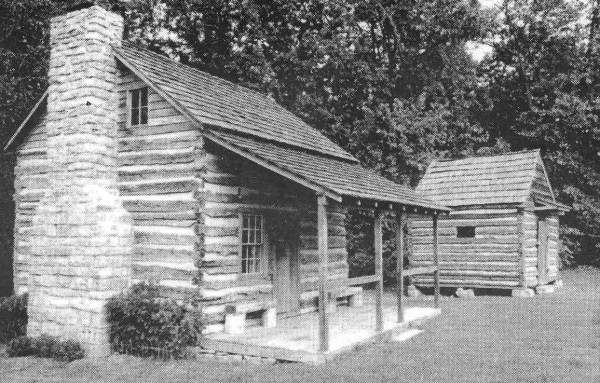
01 Lupardus and Williams Cabin at Museum You can read more about these cabins at a previous Progress Notes.
The larger of the two cabins was built by Peter Lupardus shortly after the Civil War (photo 02).
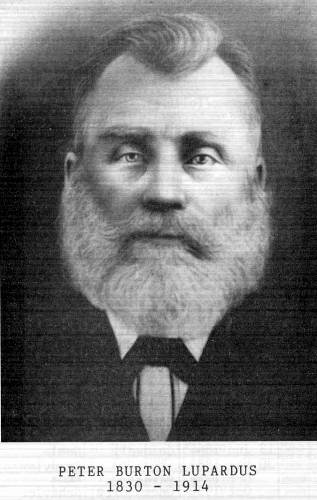
02 Peter Burton Lupardus Peter had 14 children from whom many descendents remain today in the county as well as elsewhere throughout the United States.
(Note: you can read more about the Peter Lupardus family on our own website.)
Here is a photo of most of Peter Lupardus’ family in front of the old cabin taken about 1905 (photo 03):
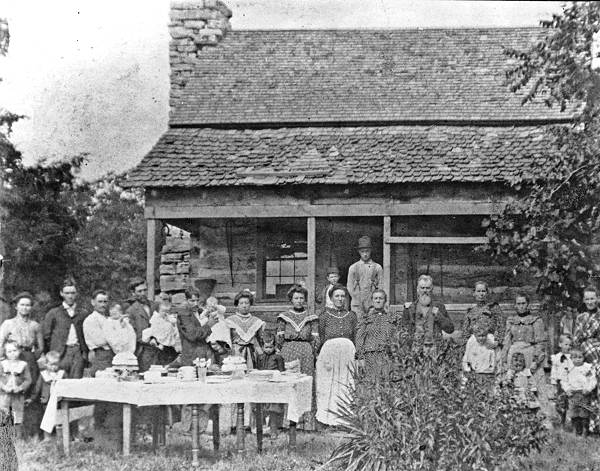
03 Lupardus Family and Cabin One of his children who was raised in the cabin was Ester “Bessie” Lupardus. She is the seventh from the left in the family photo. Bessie married Will Brown in 1907 (photo 04).
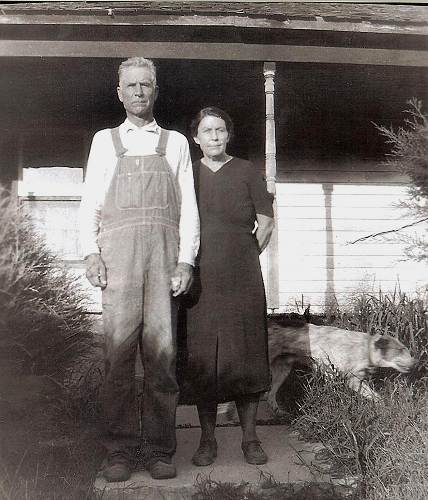
04 Will and Bessie Brown They had nine children seven of which are pictured here (photo 05) (Note: Doc and Russell are missing from the photo):
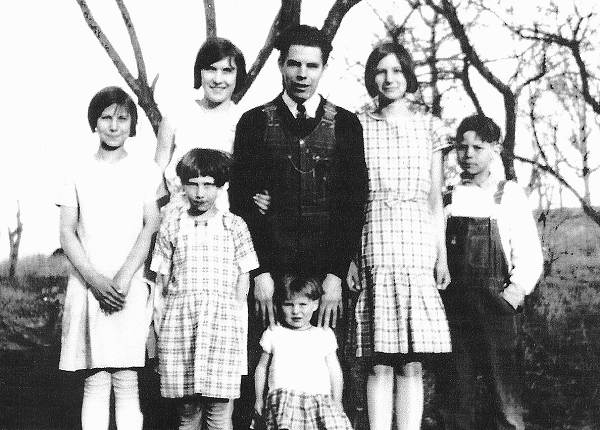
05 Fay, Lena, Earl, Lula, Mack, Lucille and Doris - Missing are Doc and Russell All of their children led successful lives and were leaders of the community in the various areas of the county where they lived. Three of the sisters have been very active in our Miller County Historical Society through the years (photo 06).
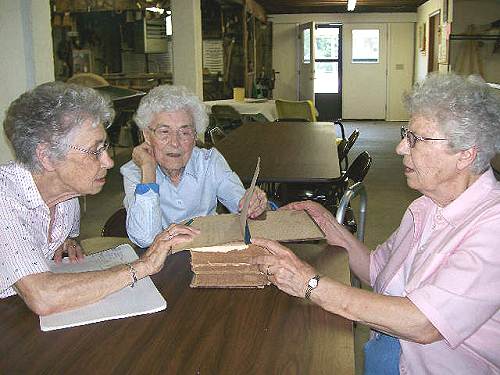
06 Lucille Brown Shockley Brightwell, Lena Brown Bear and Doris Brown Porter In this photo the three sisters are looking at a Lupardus family owned copy of Goodspeed’s History of Miller County in which Peter Lupardus, their grandfather, is featured in the biography section. This book was donated by the family to our museum.
One of Will and Bessie Brown’s children, Earl (photo 07), was such an exceptionally respected community leader for all of Miller County that I wanted to present his story this week in our Progress Notes.
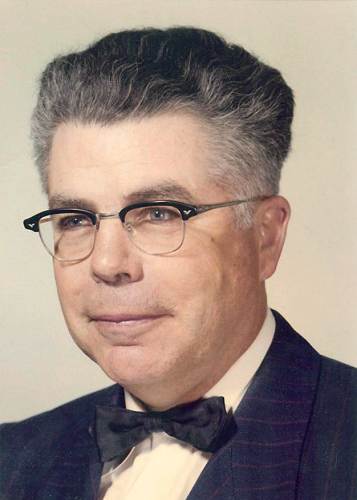
07 Earl Brown A short summary of Earl’s accomplishments in life is as follows:
Earl Basil Brown
Born: Nov. 16, 1907
Died: April 21, 1988
He was the minister of the Congregational Christian United Church of Christ in Iberia beginning in 1942.
He was a member of Iberia Ministerial Alliance and the Miller County Historical Society.
He was a minister, a teacher, a farmer, and a journalist.
He taught school in several central Missouri communities.
He was also the owner and publisher of the New Iberian newspaper for several years.
He attended Iberia Academy and Oberlin Theological Seminary in Oberlin, Ohio.
He received his master’s degree from the University of Missouri.
He studied theology in pre WWII Germany in the 1930’s.
Sandra Sue Shelton is a niece of Earl’s; her mother Lena Brown Bear, pictured above, was Earl’s sister. Sandra and her husband David, have been great friends of our museum through the years (photo 08).
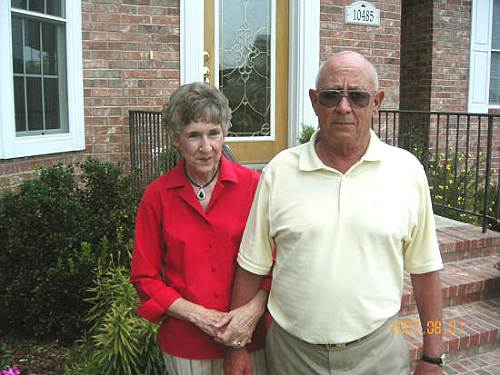
08 Sandra and David Shelton I asked Sandra if she would write for us the story of her uncle Earl Brown for which she very graciously agreed to do. The following is the interesting and informative personal biography of Sandra’s own memories of her uncle Earl Brown:
Earl Basil Brown was born November 16, 1907 to Will and Bessie Lupardus Brown (see photo 04 above). He was their first child and his early years were spent in one of Miller County’s oldest log cabins on the banks of the Osage River at Bagnell, Missouri. Although he helped his father with the farm work he also enjoyed playing with his younger siblings (see photo 05 above). Earl was an outstanding student who was very committed to obtaining an education. His grade school years were spent at Post Oak School (photo 09).
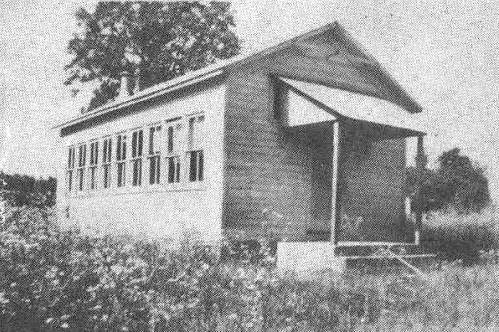
09 Post Oak School When Earl was fifteen years of age, he won a free trip to Sedalia for the State Fair for one week. He wrote a report of his experiences there, which was published in the Miller County Autogram in 1922. This was quite an experience for a young farm boy. The trip was made by train from Jefferson City and he stayed in a boys’ camp on the fairgrounds. The young men attended lectures each day on various aspects of farming and they also saw some entertaining shows in the grandstands. He especially enjoyed the harness racing. One evening there were fireworks and some athletic events in which the boys could compete. Earl wrote that he had a wonderful time and he thanked the county superintendent for making it possible.
Earl graduated from the Iberia Academy in 1930. He took his A.B. degree from Oberlin College in 1934, majoring in German and minoring in French and Greek. In 1936 he received his Master’s degree from Oberlin Graduate School of Theology. The following year he studied in Germany under an Exchange Fellowship between Oberlin College and the University Hale Wittenberg in Germany. During his one year stay in Germany, Earl learned much about Germany’s educational system and culture. He observed the militarism of the country under the dictatorship of Hitler. He actually heard Hitler make a speech once at large public event. He also encountered Hitler on a train platform once. Earl said that he was standing at the door, waiting to exit the train and when the door opened Hitler was standing right in front of him waiting to enter the train. He was surrounded by several bodyguards.
The following photo was taken at the Training Camp for German teachers of English (photo 10).
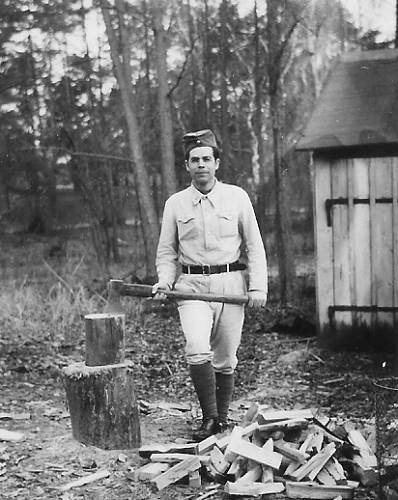
10 Earl Brown in Germany Shortly after Earl’s return to the states, his first wife, Ruth Nelson, died. I am not sure when they married, or where she was from (photo 11).
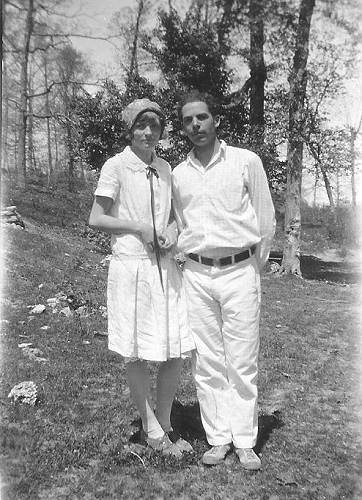
11 Earl Brown with first wife Ruth Nelson Soon after that Earl went to Kansas where he was a minister to a small church in Gaylord, Kansas. There he met and married Lorena Bechtold (photo 12).
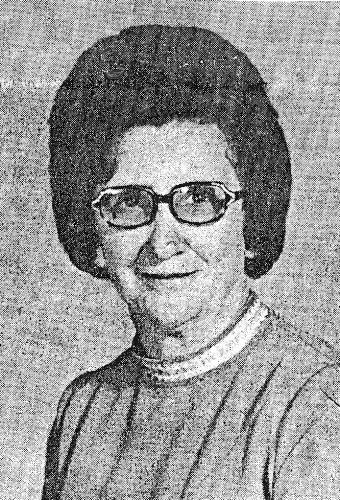
12 Lorena Bechtold Brown Earl’s sister, Fay, had been keeping house for him in Kansas before he married, and that is how Fay also met her future husband in Kansas, Harold Bechtold. Harold and Lorena were cousins. Then Harold’s sister, Midge Bechtold, got acquainted with Fay’s brother, Mack, and they got married as well. So, the Brown and Bechtold families were intertwined and their children enjoyed the distinction of being double cousins.
Near the end of 1938 the newly married Earl and Lorena, moved to a larger church in Houstonia, Missouri, where they served the community church there for four years. They were then called to return to Iberia where they made their permanent home. Earl and Lorena became the parents of two children. Carol Kay was born in 1943 and Douglas was born in 1947. Their father had the pleasure of baptizing them both into the church, and in due time of holding their infants in his arms and christening them.
Lorena was very helpful to her husband in the ministry of the church. She also served as a public school teacher at Waynesville for twenty years.
While living in Iberia, Earl taught at the Iberia Academy. He owned and published a newspaper, and he raised cattle. At one time he also had a chicken hatchery. He and Lorena built a lovely home and enjoyed entertaining family and friends with fish fries and watermelon feasts. Earl loved flowers and created a beautiful rose garden, in which he had over one hundred varieties of roses.
Earl and Lorena had four grandchildren. Carol Kay had two daughters, Stephanie and Shelley. Douglas had two sons, Michael and John. Stephanie reminisces about “hanging out” with her grandfather in the print shop and spending time with him on the farm, especially around the big fountain in the back yard. She has fond memories of the fish fries and going to the State Fair with him on several occasions.
Earl had the pleasure of officiating at the marriages of his own children, several of his siblings as well as some of his nieces and nephews.
I have fond memories of Uncle Earl riding in the tire swing with me at the Riverside Park at Tuscumbia (photo 13).
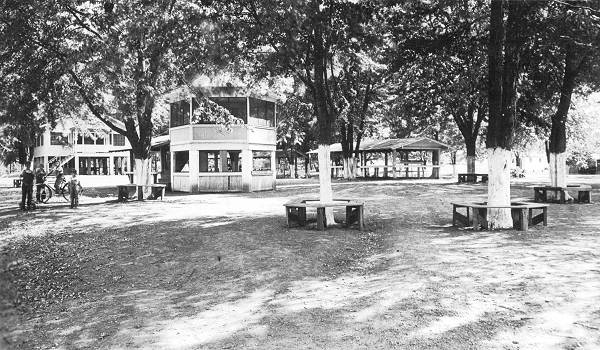
13 Riverside Park - Tuscumbia Note: Sandra lived her first four years in Tuscumbia before moving to Eldon with her parents, Arthur and Lena Bear.
It was a thrilling experience because the swing was attached to a huge tree near the river. We would fly so high that the swing would go way out over the water. He was always a devoted uncle who would attend my special occasions, sometimes making an impromptu speech suitable for the event, and he was a gifted public speaker. I was born the year that he spent in Germany, and he sent me a little white toy dog from one of the factories that he toured. I was proud that Uncle Earl could be the minster at my wedding.
Lorena Brown passed away January 7, 1988.
Reverend Earl Basil Brown (photo 14) passed away just three months later on April 21, 1988.
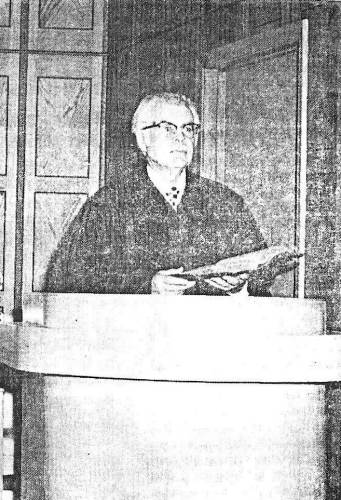
14 Reverend Earl Basil Brown
Thanks Sandra for sharing those memories of your Uncle Earl with us.
While Earl was still a student at the Iberia Academy, he was ordained into the ministry on June 9, 1929 by the church officials of the Christian church in Eldon. Later on in 1952, he was re ordained into the Congregational Christian church of Iberia, Missouri. The following essay of Earl’s was a paper submitted by him in support of his candidacy for this ordination. In it he gives the story of his life, important influences, and the philosophy of living which he developed over the years of his career as a minister and businessman:
A Paper
Submitted by Earl Basil Brown
In support of his candidacy for Ordination in the Congregational Christian Fellowship
I was the first born into a family where the mother was a member of the Newlight Christian Church and my father had made no confession of faith into any denomination. The church of mother’s choice was the one which later, to a general degree, united with the Congregational Church. She was a good Christian mother not laxing in her religious duties, nor over zealous in the pursuit of them. While my father did not belong to any church, nor take an active part in their programs, he possessed many of the virtues of a Christian man. Those desirable traits set an ideal for his ever increasing family.
While I was still a very young child, into the home of my parents came my paternal grandfather to live for many years with our family. Having felt the urge to expound the scriptures, he practically dropped the plow lines to his horses in the furrow where they stood and began giving vent to his mind through his lips, instead of his strength through his hands. To the best of my knowledge, he began his ministry in the Missionary Baptist faith. Thereafter, he became a wandering preacher in the hills of the northern Ozarks to scattered congregations that would gather to hear him in school houses, brush arbors, private homes and other such places which were open to him.
Note: In the paragraph above Earl is referring to his paternal grandfather, James Brown, who was a circuit riding preacher of the 19th century. Here is a photo of him with his son Will and granddaughter Lena Brown Bear and her daughter, Sandra Bear Shelton (photo 15).
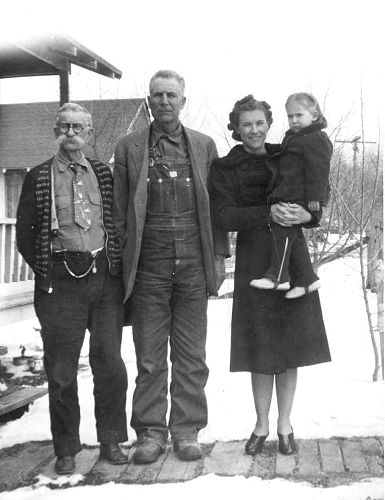
15 James and Will Brown, Lena and Sandra Additionally, here is a photo of the black frock coat James wore when he rode his horse on his ministry circuit (photo 16).
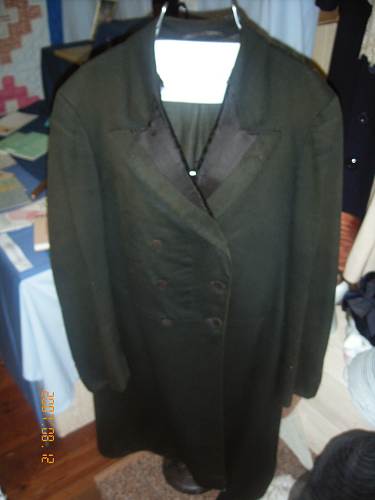
16 Frock Coat of James F. Brown The frock is on display in the church section of our museum.
This candidate is unable to form a conclusion whether these influences had any effect in determining the course he himself was to take in later life. Undoubtedly, they cannot be ignored. But the impetus was given to the direction he was to take when he sat at the feet of a great thinker and spiritual man who was head of Iberia Academy where he began the more serious aspect of his educational experience.
Under the guidance of G. Byron Smith of the Iberia Academy and Junior College, and some other fine people, both in and out of the school, some of my thoughts and actions were led in the direction of desirable fields (photos 17 and 18).
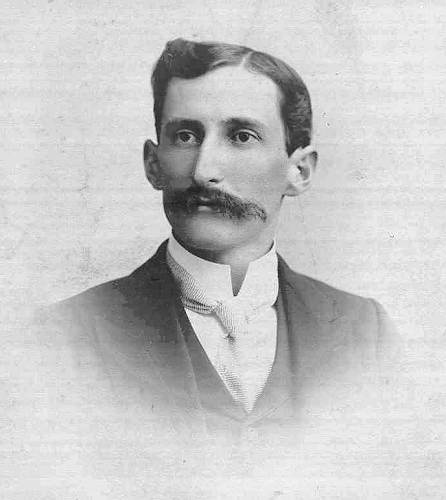
17 George Byron Smith - Iberia Academy
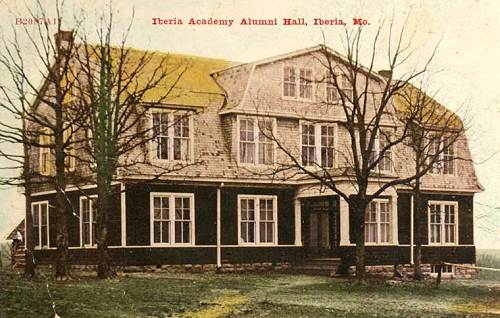
18 Iberia Academy Alumni Hall - 1906 Very soon they taught me by precept the importance of a religious life. During my second year in the Academy, at the age of 19, I united with the Christian (Disciple) Church. In my third year, I was elected President of the student YMCA organization in the school. Under this auspice I attended conferences at Hollister, Rolla, and other towns in the state. Perhaps it was at such a rally at Rolla that I decided to think in terms of becoming a minster. On a Sunday morning in the Baptist Church there, I spoke briefly before the congregation, thanking the people for the courtesies shown the delegates of our YMCA convention. When I returned to my seat, Frank B. Liddle, State Secretary of the student YMCA, from St. Louis, stood in the pulpit and turning to face me, uttered these words, “Brown, I am not sure but that some day you will become a preacher.” These words became a living fire in the furnace of my soul.
Soon thereafter while still a junior in the Academy, I accepted the opportunity to preach on Saturday night, Sunday morning and evening at the little Pleasant Hill Church five miles southwest of Iberia. These services were one weekend once each month. Then the Christian church at Ulman called me for similar services once per month.
After school closed on my junior year, I was ordained on June 9, 1929 at the Christian (Disciple) church in Eldon. Upon my return to the Academy for my senior year, I continued to serve these two churches and in addition the Christian Church off the campus in Iberia asked me to serve it. That I did, and consequently three weekends per month found me in the field serving a church. During this year, I received two girls into the church at Ulman according to their wish to be baptized by immersion.
For my under graduate work attended Oberlin College, Oberlin, Ohio, from 1930 to 1934, majoring in modern languages. During this time I had a one semester course in Bible taught by a very able scholar, Miss Fitch of the Oberlin faculty. After receiving my A.B. degree, I entered the Oberlin Graduate School of theology. My first year in the graduate school was spent in the regular course leading to a B.D. degree. In my second year I made a change in my course of study so I could take a Master’s Degree before acquiring the B.D. degree. The reason for this was that by taking the M.A. first, I could save a semester of work. In the spring of 1936 I was granted the degree of Master of Arts in New Testament. Professor Clarence Tucker Craig was my graduate advisor. For the M.A. degree, in addition to the written and oral examinations, I submitted a 125 page thesis on the subject, The Lost Source of the Synoptic Gospels…A Study In “Q.”
Note: regarding the “Q” writer the following is taken from Wikipedia:
“Source criticism is the search for the original sources which lie behind a given biblical text. It can be traced back to the 17th century French priest Richard Simon, and its most influential product is Julius Wellhausen's Prolegomena zur Geschichte Israels (1878), whose "insight and clarity of expression have left their mark indelibly on modern biblical studies." An example of source criticism is the study of the Synoptic problem. Critics noticed that the three Synoptic Gospels, Matthew, Mark and Luke, were very similar, indeed, at times identical. The dominant theory to account for the duplication is called the two-source hypothesis. This suggests that Mark was the first gospel to be written, and that it was probably based on a combination of early oral and written material. Matthew and Luke were written at a later time, and relied primarily on two different sources: Mark and a written collection of Jesus's sayings, which has been given the name Q by scholars. This latter document has now been lost, but at least some of its material can be deduced indirectly, namely through the material that is common in Matthew and Luke but absent in Mark. In addition to Mark and Q, the writers of Matthew and Luke made some use of additional sources, which would account for the material that is unique to each of them.”
For a time during my under graduate work in Oberlin I taught a Sunday School class in First Church in Oberlin. Occasionally I went out to a small town such as Wellington to preach. Then, I went to the East Oberlin Community Church where I worked with the young people and substitute preached for the pastor. During my graduate work I preached full time in the Community church in Elyria, Ohio.
The spring I completed my Master’s Degree in 1936, I was awarded an Exchange Fellowship to the university of Halle-Wittenberg, Halle, Germany, where I studied under the men of the theological faculty, such as Dr. Klosterman in New Testament, Dr. Woffe in church history and Dr. Schniewind in Philosophy. During my sojourn in Germany I traveled extensively, covering most of the nation with the exception of the extreme northeast part. Before going to Halle to begin my exchange fellowship studies, I spent a month at the University of Hamburg studying and further acquainting myself with the German language. I spent some time in Frankfurt, Heidelberg, Stuttgart, Munich, Oberammergau, Berchtesgaden, Leipzig, Berlin, Cologne, Essen, Düsseldorf, Bremen and Salzburg, Austria.
Note: in the 19th and early 20th centuries Biblical Scholarship was concentrated in Germany. You can read more about it on Wikipedia.
The last part of my stay I was employed by the Department of Education of the German government to do lecture work in two separate teacher training institutes: one for east Germany southeast of Berlin and one for west Germany near Duisburg Am Rheine above Cologne (photo 19).
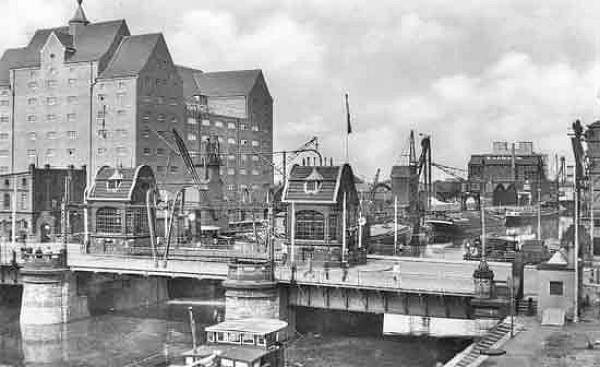
19 Duisburg Am Schwanentor Before my return to the states, I had completed my registration at Yale University to work on a PhD degree, but because of the death of my first wife upon my return home, was forced to forego that privilege and go into the field and seek work. Through the help of a very dear friend, who was then State Minister of the Congregational Christian Conference of Missouri, and who is this night to preach the ordination sermon, I secured a small church in a rural setting in the Solomon River valley at Gaylord, Kansas. Here, after a time, the sting of death gradually slipped away and I became quite happy in my work. Later I remarried, taking a girl out of my congregation to become my wife.
Around Gaylord was a large German Lutheran community which received me graciously because of my recent stay in the home land of their fathers.
After one year at Gaylord, I came to the Community Church at Houstonia, Missouri, at the suggestion of Dr. Charles C. Burger. This was a very new organization of 225 people from the Methodist, Baptist and Christian denominations then functioning in Houstonia. A splendid organization of young people developed through a combination program of religion and recreation, parties and folk dances. After four fruitful years spent in Houstonia came then the war and scattered our young people over the face of the globe.
At this time, President Smith requested that I come back to Iberia and become a part of the Junior college faculty teaching religion and having charge of the social life of the college students. Upon my return to Iberia I was invited by the local Congregational Christian Church to preach for them until a minister could be procured. After nine years I am still here and therefore have the happy privilege of bidding you welcome this night.
Over this period of years as far as my convictions are concerned, I find my field of thought limiting and crystallizing. This experience is much like a lad reeling in his kite string on a windy day. I find myself becoming less and less concerned about the abstract things of the sky and more and more concerned about the worth and dignity of man. I do not entertain the slightest doubt but that there is a power outside of, and beyond the concepts of man’s mortal mind usually referred to as the Creator, and known to later generations as God. To me this God has taken on his most significant meanings through the brief and busy life of a mortal man who walked among men, one known as Jesus and referred to as the Christ. I am sure we have not overworked the concept of the Holy Spirit in man’s relations with one another and with the unknown. I do not place any fanatical supernatural significance in the writings called the Holy Scripture, but look upon them as the serious efforts of sane men seeking to lift themselves up into that mental and spiritual realm from which they could look down upon the world and feel that all things were beneath their feet. I do not subscribe to the condition that if any one part of the Bible is to be believed, each and every other part must likewise be so considered. It is my deep and ever growing conviction that man can have fellowship and communion with God sitting on the brink of a river bank as well as leaning forward on the edge of a pew in the auditorium of a church; in walking along quiet paths in green pastures underneath a cloud fleecy sky as well as marching hush mouthed and sedately down velvet carpeted aisles of a sun splashed sanctuary; that one will not necessarily go to heaven because of a fanatical concept that every one ought to be in church every Sunday or that one will necessarily go to Hell because he communes with his God in the great out of doors. I believe every man ought conscientiously to strive toward that goal of the high calling of which Paul spoke, but let him seek after it according to that fashion which will make him the best man and the most desirable.
In other words, we have man; that cannot be denied. He is a physical reality; a very present thing in time of consideration. Therefore, we are not forced entirely to deal in the abstract, but have something very definite and concrete with which to work. And when this man becomes, according to our mental and spiritual concepts, more God like, the more we will have the Kingdom of God on earth.
Thus it is my desire, in so far as my powers and abilities will permit, to help this man rise above himself. I would have him discover the value of himself in this physical life rather than seclude himself from the harsher elements of this world, like a monk in a cell, waiting for the promise of that which, as yet, is so darkly veiled from our eyes. Thus, if man, having made the world more God like, dies and beyond the grave there is something, he has double won, but if there is nothing, he still has not lost and the world is better. Let man, through his own endeavors, rise to his greatest capacities, and the God who created him will wisely take care of the rest.
So help me, God, Amen
Sandra mentioned that Earl had written about the log cabin where he was raised his first few years of life. It is certainly interesting to note that both Earl as well as his mother spent their childhoods in a log cabin. Here are Earl’s memories of living in a log cabin:
Miller County History
June 17, Page 11 (Miller County Historical Society)
Rural Log Cabin Life Story Recalled
By Earl Basil Brown (photo 20)
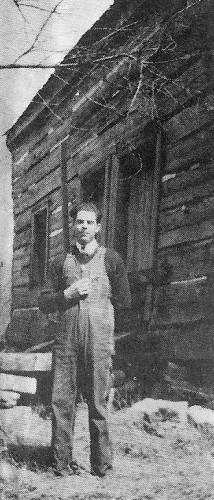
20 Earl in front of Boyhood Home - 1930 This story concerns one of Miller County’s oldest log cabin homes. Its earlier history is not known to this writer. He was born within its bleak walls on November 16, 1907, and retains fond memories of the first seven years of his life lived there.
The dilapidated structure was completely destroyed and washed away during the greatest flood ever recorded of the Osage River in 1943.
The original structure was about 20 by 40 feet in size and consisted of two rooms divided in the middle by a solid walnut planking about two inches thick.
All clumsy made doors, window frames and divider paneling were of solid walnut. The kitchen and eating area were in the west (right) end and the living sleeping quarters were in the east (left) end.
A useable stair led from the kitchen to the loft above which was one large single area. Across the narrow part of this space was a large walnut beam some 8 by 12 inches in size placed at the top of the last logs in the wall construction to tie the walls firmly in position.
This writer learned to ride on this beam and called it his saddle pony.
In each end of the cabin was a large fireplace made from large hand hewn stones. These were the only sources of heating.
The original roof on the cabin had been made of white oak shakes split and formed on the farm. Later a corrugated galvanized iron roof was nailed over the deteriorating shakes.
Before the Brown family occupied the structure, some previous dwellers had added a room and porch lean to the south side.
Water resources came from a hand dug well in the back yard and was about six feet in diameter and 30 feet deep. The top of this well was boarded over to keep children from falling in.
Water was drawn up through an opening by a three gallon bucket on the end of a sturdy rope.
Needless to say, this was a most fitting breeding ground for typhoid fever bugs. People who drank the water paid the penalty every spring and survived by consuming buckets of quinine and Groves Chill tonic.
During its lifetime some spooky tales grew up around this old house. At one time this cabin was the home of the Brandt family. He was a carpenter of sorts. Rumor had it Mr. Brandt made coffins for the dead. In later years one could hear the sound of sawing and hammer strokes in the upstairs loft as Brant continued to make coffins for the dead.
Another tall story concerning the cabin went back to the Civil War days. In each of the two upstairs gables a round hole of about two inches had been cut. It was said the owners of the property had thrust a musket barrel through those holes and fired shots at marauding strangers.
The big river bottom farm upon which this log cabin stood belonged to a German gentleman by the name of Hermann E. Naegelin of Morrison, Missouri. This writer does not know how the property came into the possession of Mr. Naegelin nor does he know how the Brown family became connected with the farm.
In January, 1907, William (Will) Brown and Ester Bertha (Bessie) Lupardus, both of Ulman, Missouri, were united in marriage at the home of the bride’s parents near Ulman by the Reverend M. Charles Sooter (photo 21).
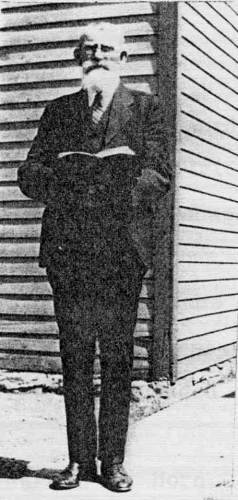
21 Charles Marriot Sooter Immediately thereafter the newlyweds moved to the Naegelin farm across the river from what is now old Bagnell.
This log cabin became the home in which Will and Bessie Brown began their married life.
On November 16, 1907, of their marriage year, their first child, a son, was born. Two years later a second son came and another two years later the first daughter was born.
After the Brown family lived in the old log house for seven years, Mr. Naegelin had a new and more up to date house built at another location on the crest of a high hill. Into this new home the growing Brown family moved. The family grew to nine children.
During the summer the mother and her helping youngsters carried the large weekly wash to the river bank’s edge and prepared for the all day clothes laundering.
A very large iron kettle was set on its wagon wheel rim tripod; a roaring fire made from plentiful driftwood was kindled under the kettle until the river water boiled furiously and the hand rubbing of fabrics on corrugated washboards in different laundry tubs began in earnest.
Note: on display in our museum is the type of big iron kettle commonly used in those days (photo 22).
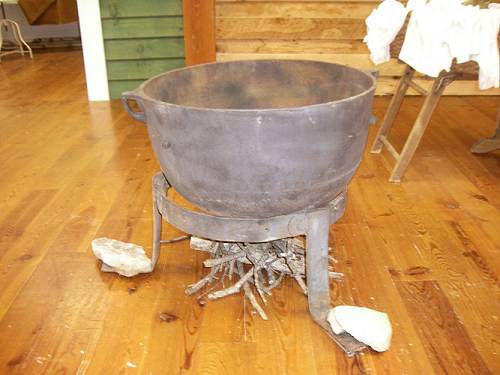
22 Iron Kettle At times a large river raft composed of some 1200 to 1500 hand hewn railroad ties floated slowly by. A mile on down the river the raft would be maneuvered into the tie yard area where docks were located. The water soaked ties would be pulled up the bank on a small type of railroad flat car, hauled to the spreading tie yard. At a later time they were loaded into special railroad cars for shipment all over the U.S. (photos 23 and 24).
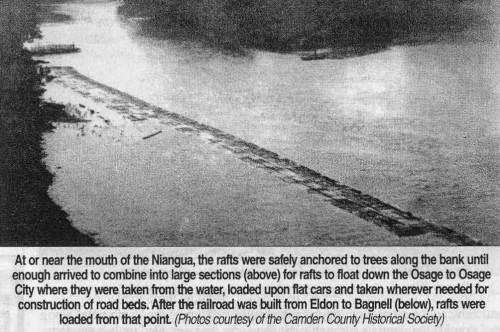
23 Tie Rafts going Downriver
Click image for larger view
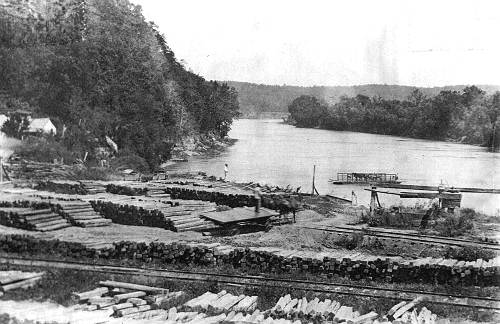
24 Bagnell Tie Yard In front of the cabin home ran the county roadway, maintained by poll taxes. This dusty, and at other times, axle deep muddy road carried various kinds of traffic including herds of cattle, numerous droves of hogs on the way to St. Louis markets and occasionally flocks of sheep.
The road crossed the river at Bagnell on a large ferryboat (photo 25).
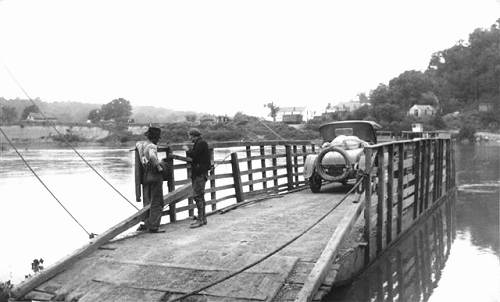
25 Bagnell Ferry In years to come this old roadway became modern U.S. Highway 54, which it is today. Its bed location changed radically from over the ferry at Bagnell to a point quite westerly where it was re located over the newly constructed Bagnell Dam.
Earl Brown was one of those unusual men who gave himself to public service and caring for his fellowman. He was involved in so many community activities one could hardly list all of them. He was always called upon to help with public events. One of those was the sesquicentennial celebration held in Tuscumbia in 1976 when he happily judged a tie whacking contest (photo 26).
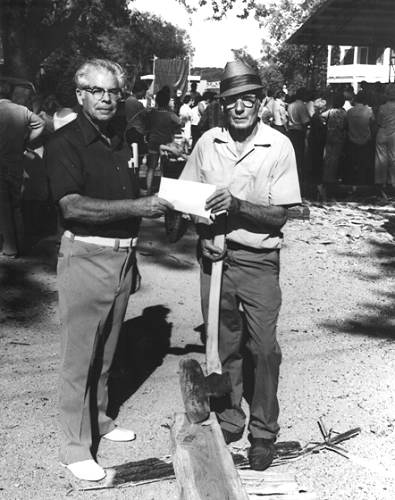
26 Earl Brown giving Arthur Clark the Tie Whacking Award at Sesquicentennial Peggy Hake, our Miller County Historical Society Secretary, who is a native of Iberia, remembers Earl:
I had known of Earl most of my life. He pastored the Iberia Congregational Church for more years than I can remember and also when he was the owner-editor of The New Iberian Newspaper. He was a graduate of Iberia Academy in the class of 1930.
When I was living in Kansas City in the 1970s I began to research and write historical and genealogical papers concerning my family that later extended out to many of Miller County's pioneering families. Earl said he would like to feature some of my stories and that is how my writing career began.....He was a wonderful writer and I always enjoyed reading his memories of childhood as he grew up in the area around Old Bagnell and the Bear Creek vicinity......he had a wonderful heritage with a true stock of early pioneer ancestors that settle in that part of western Miller County.
His wife, Lorena, was such a dear lady. I will never forget the time she and I, along with other folks from Iberia, traveled on a bus tour to the Branson area and visited Silver Dollar City amusement park. They had some of the wildest rides I have ever experienced and, being her partner, we didn't miss one of those rides. What a great vacation spot and a day of good fun we shared!
Thanks for the memories, Peggy.
So that completes the narrative of Earl Basil Brown, one of Miller County’s most public minded and selfless citizens. He is one of those to whom we can look for example, philosophy and citizenship.
In 1979, Mr. and Mrs. Oscar Wilson of Iberia applied for registration of certain buildings of the Iberia Academy in the National Register of Historic Places Inventory of The United States Department of the Interior Heritage Conservation and Recreation Service. As part of this process an application was made which included an interesting historical narrative and photos of the four major buildings on the campus at a time when they were still being well maintained. I thought this week might be a good time to present this information to readers of the website since Earl Brown was closely associated with the Academy during his life.
Iberia Academy
Oscar and Myrtle Wilson
December 1979
Sitting almost in the center of Iberia, Mo., the Iberia Academy and Junior College campus is comprised of four buildings that sit at odd angles within a triangle of approximately 2.66 acres. Three of the four buildings, the dormitory, the administration building and the gymnasium, were constructed largely with student labor. The fourth structure, the "president's home," is believed to have been an existing structure acquired by the academy and absorbed within the property around 1909.
Note: here is an aerial map of the campus and a diagrammatic of the layout of the buildings (photos 27 and 28):
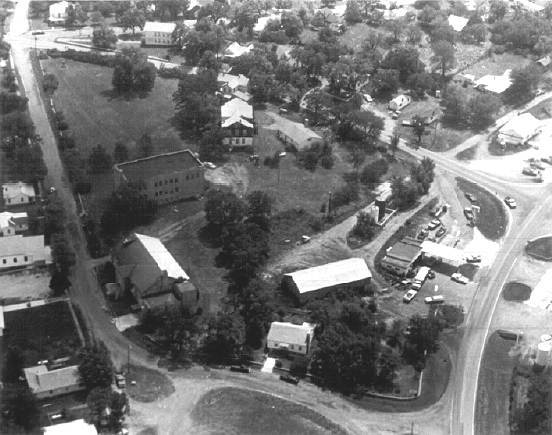
27 Aerial Photo of Iberia Academy
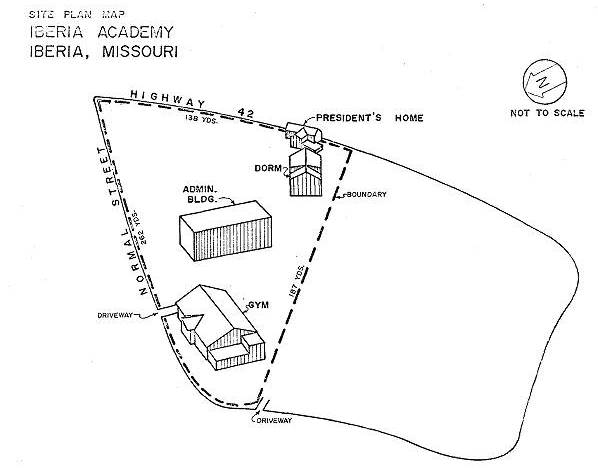
28 Iberia Academy Map A rock wall marks campus boundaries and at the east end of the triangle lies a stone gateway dedicated in the early 1900's by Harriet Nichols Smith, mother of the Academy's founder, G. Byron Smith. A large stone monument stands about ten feet inside the gate (photo 29).
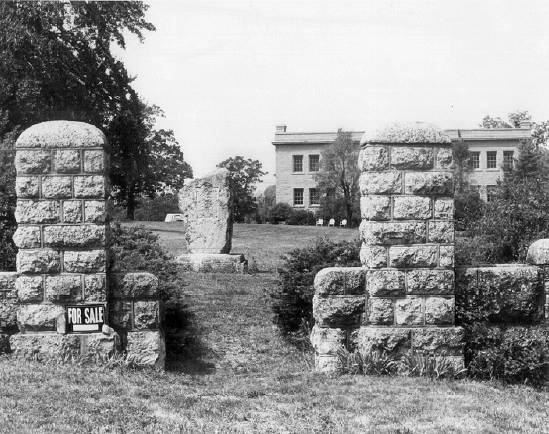
29 East Entrance Gate - Monument and Administration Building EXTERIOR
All four buildings appear to be structurally sound and in good shape on the outside. Two of the structures, the gym and the "ad" building are of native limestone.
Stone for "Martin Gymnasium," named for an early benefactor, was gathered on the premises and from another spot north of Iberia (photo 30).
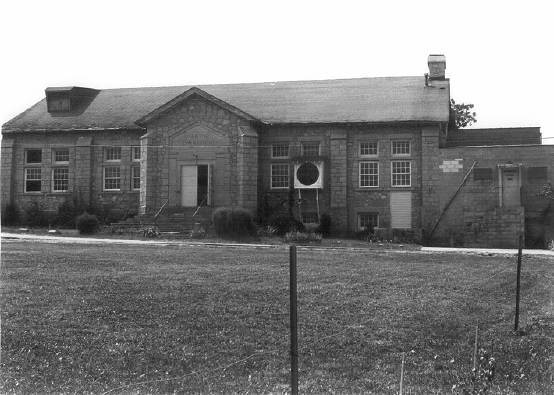
30 Martin Gymnasium - Main Entrance North Side The coursed rubble stonework is set within large buttresses on a 45' by 90' rectangular floor plan. A pilaster-effect was added to the main entrance on the north side, cut in three pieces and installed by students. The pilasters' caps were hand-cut by stonemasons from Iberia as was the engraving in the triangular pediment above the main entrance of the gym (photo 31).
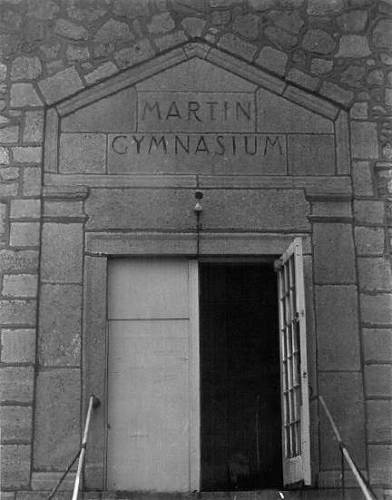
31 Martin Gymnasium - Main Entrance Door Finished in 1927, Martin Gymnasium was topped with a medium-gable shingled wood roof which is still intact. A shed type dormer was added near the southeast corner.
The same 45' x 90' dimensions were used for the floor plan of the other stone structure, the Administration Building. Built around 1922-1924. The present structure replaced the original structure which burned in 1917 (photo 32).
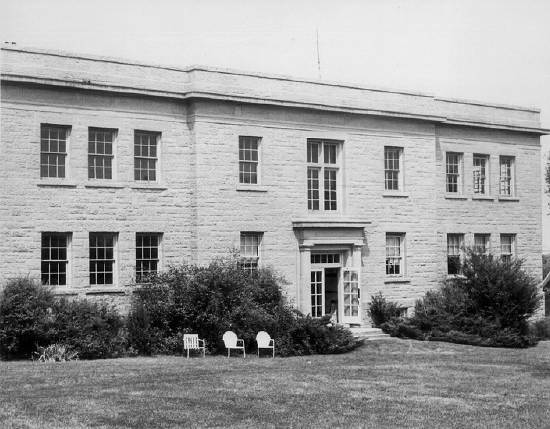
32 Aministration Building - Northeast Side Entrance Student laborers and Iberia stonemasons again used native limestone but the rusticated ashlar stonework of the "ad" building consists of larger and more evenly cut stones than those of the gym. Being basically a classroom building the architecture is rectangular and simple though lasting and functional. Stone lintels were placed above the windows as was a large entablature above the double doors of the main entrance on the east side of the administration building. The wood roof is flat and tar covered.
In contrast the girl's dormitory or "Alumni Hall," built in 1905, is a wood frame structure with a garnbrel type roof (photo 33).
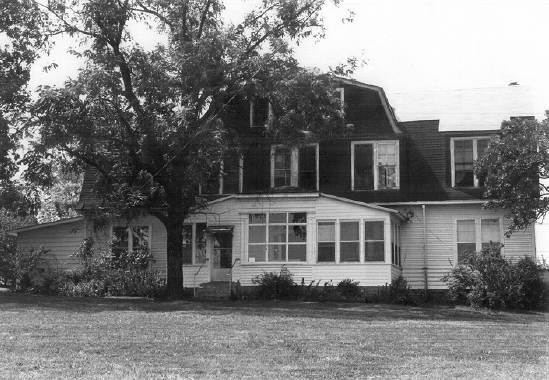
33 Girl's Dormitory - Main Entrance East Side All 3 stories, originally shingled, are now covered with weather-boarding. Built on a 45' x 90' rectangular floor plan with an exterior brick chimney in the rear or the southwest facades, it resembles a large residential home more than a modern-day dormitory.
The oldest building on campus is the president's home believed to have been built about 1888 and later incorporated into the Academy's campus (photo 34).
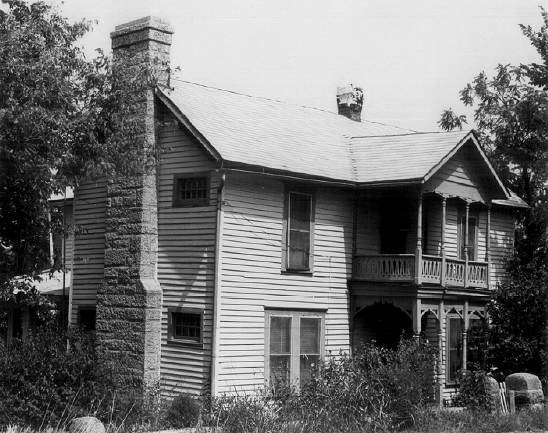
34 President's Home - Main Entrance South Side It is a two story frame I-type house with a medium gable roof and extended cross gables that cover the rear portion of the house and the front porch and balcony. A back porch wraps around the rear wing of the first floor. The house has two chimneys, one offset to the right and the other on the exterior of the west end. The interior chimney is brick while the exterior appears to be of larger rusticated random ashlar stonework, much the same as the stone used for the administration building. While the house is vernacular the ornate railings and columns of the front porch suggest Eastlake style influence.
INTERIOR
While the exteriors of all four buildings have undergone minimal changes that is not the case with the interiors. Only the Administration building remains unchanged inside. Although it stands vacant, the large high ceilinged class rooms, library and chapel room are just as they were when construction was finished in the early 1920's. Two original large stone fireplaces in the first floor are probably the most interesting interior architectural features of the administration building (photos 35 and 36).
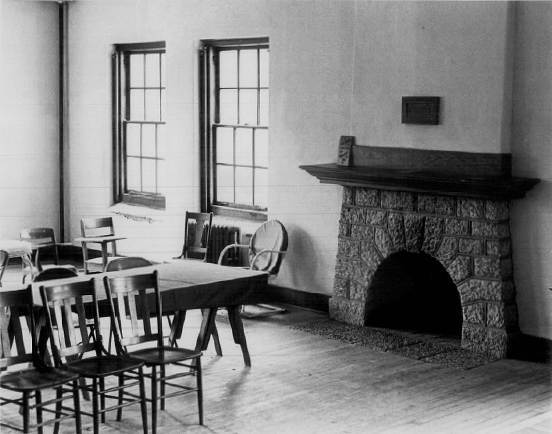
35 Administration Building - Whitelaw Chapel - First Floor
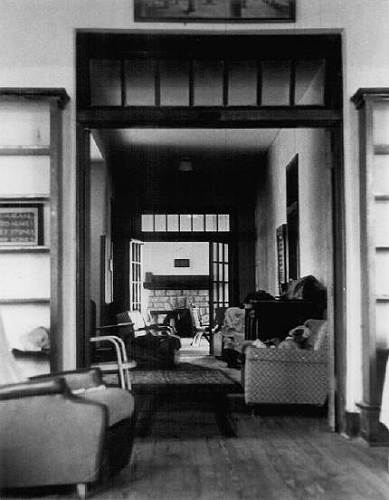
36 Administration Building - View from Library into Whitelaw Chapel - First Floor The interior of Martin Gymnasium was altered in the early 1960's to serve the industrial purposes of a raincoat company, although it is used today by another manufacturing company. A middle floor was added as was a one-story concrete block addition that extended the length of the first floor by 16 feet to the northwest.
The interior of Alumni Hall has also been modified to suit a purpose other than the original. Individual rental apartments are now sectioned off and basic remodeling has been done. The old dining room parlor and kitchen are now separate apartments and additional plumbing has been added to serve this purpose. Two things that have remained intact are the original woodwork and nameplates on several doors honoring benefactors that date to the year of construction, 1905.
While the President's house has always been a residence and remains so today, it has undergone some interior remodeling. Plumbing has been added and repainting, carpeting and paneling have all been undertaken,"however, no major structural changes have been made.
ALTERATIONS
Other than the interior changes and the previously mentioned block addition to the gym relatively few alterations have been made through the years to the campus and buildings of Iberia Academy. A closed-in frame porch was added to Alumni Hall's north entrance in the 1950's. What had been an open portico entrance porch with wooden piers was enlarged with shed-roofed extensions to either side and enclosed with windows and weatherboarding. The original doorway and porch columns remain intact within this addition however.
FOOTNOTES
1. A personal interview with Oscar Wilson, present owner, by Launa Jones, April, 1979.
2. "Half Century of Progress: 1390-1940," Iberia Junior College Bulletin, semi centennial number, New Series, vol. 15, no. 2, p. 3.
3. A personal interview with Rev. Earl Basil Brown, former student, by Launa Jones April, 1979.
4. Ibid.
5. A personal interview with Robert Law, former student and board of directors member, by Launa Jones, April, 1979.
As one of the first sources of secondary and college level education in the southern half of Miller County, the Iberia Academy is historically significant in the area of education. When the first class convened on October 1, 1890, there was not a high school within ten counties. Not until the Public school system began in Iberia in the early 1940's did the academy discontinue the first two years of its four year secondary curriculum.
Supported mainly by the Congregational Church, the Academy was known early on as the "Ozark Experiment", which was a reflection of its uniqueness in the area. It exemplified not only an educational interest from outside the rural Ozark community but also a determination from within the community itself not to be denied education.
The school was founded by a Congregational minister from Arkansas, Richard T. Harlow, and a couple from Illinois, Mabel and G. Byron Smith. As teachers and administrators the Smiths provided leadership-for the Academy for half a century. But it was the students themselves that made the Ozark Experiment pay off. Work of every kind was done by student labor, including most of the construction of the buildings.
While religion and athletics were prominent, the Academy also offered Latin and Greek besides English, history, math and science. According to Mabel Smith the result of this was: "Cabin homes are thus transformed from the commonplace to the centers of culture."
In 1929, Mrs. Smith wrote that the south half of Miller County was a section of country almost as large as the State of Connecticut in which not an hour of college credit was offered. In that same year the Iberia Junior College was started at the Academy and dubbed "experiment number two".
The success of this second endeavor would later have a direct effect on the area's educational system. According to Dr. John Bearden, superintendent of Iberia schools from 1958 to 1965, one-half of the faculty of those schools were graduates of the Iberia Junior College. In addition, teachers who had received their associates' degrees at the Academy made up the bulk of educators at nearby Crocker, Waynesville, Dixon, Tuscumbia and School of the Osage in Lake Ozark.
However, the advent of the public school system began to hurt enrollment in the 1940's and church funding also began to dwindle resulting in a switch towards a more agricultural curriculum at the Academy.
For a brief two years the Academy became Conservation College before closing permanently after the final commencement in 1951. Records and libraries were forwarded to Drury College in Springfield, Mo., another institution supported largely by the Congregational Churches of the state. The former campus, with its buildings, was sold to Henry Thompson of Iberia, who later sold the property to Oscar and Myrtle Wilson, the present owners.
FOOTNOTES
1. Mabel Smith, "An Experiment in the Ozarks," 1929. Reprinted in "A Half Century of Progress: 189'6-1940".
2. Personal interview with Dr. John Bearden by Launa Jones, April 4, 1979.
3. Mabel Smith essay.
4. "A Half Century of Progress" 1890-1940,: Iberia Junior College Bulletin, semicentennial number, New Series, vol. 15", no. 2, p. 1.
5. Ibid., p. 15.
6. Mabel Smith essay.
7. "A Half Century of Progress: 1890-1940." p. 4.
8. Dr. John Bearden, unpublished doctoral dissertation, "Determination of Needs, Potential support and Planning Sequences for a Lake of the Ozarks Junior College," 1970.
9. Personal interview with'Rev. Earl Brown, former publisher of New Iberian, by Launa Jones, April 7, 1979.
2. Iberia Junior College Bulletin. "A Half Century of Progress: 1890-1940." semicentennial number, new series, vol. 15, no. 2, 1940.
3. Bearden, John. Interview, 4 April 1979.
4. Brown, Earl Basil. Interview, April, 1979.
5. "Half Century of Progress: 1890-1940." Iberia Junior College Bulletin, vol. 15, no. 2, p. 3.
6. Law, Robert. Interview, April, 1979.
7. Smith, Mabel. "An Experiment in the Ozarks." Iberia Junior College Bulletin, 1929.
8. Wilson, Oscar. Interview, April, 1979.
Much more about the history of the Iberia Academy can be found on our website at several locations. I placed Peggy Hake’s very detailed narrative about the Academy last year on the President’s Page.
The article is quite complete as written by Peggy and includes many photographs.
Continuing the C.B. Wright diary excerpts, this week’s entry from the Tuscumbia Autogram for the month of June 1912 records a round trip by steamboat to Hoecker (photos 37 and 38).
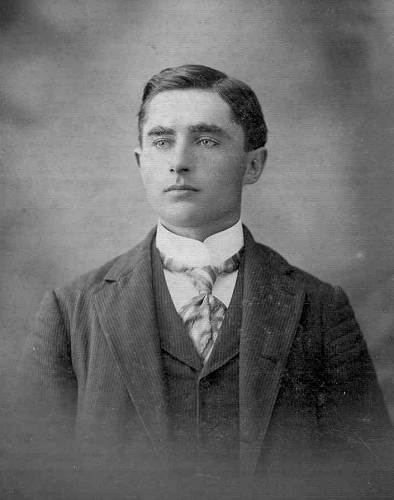
37 Clarence Wright - Age 25
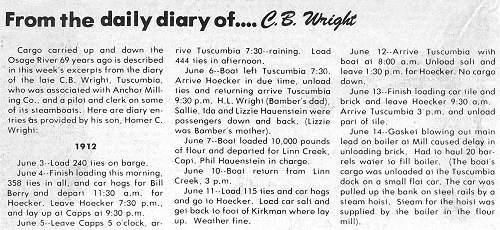
38 C.B. Wright Diary - June 1912
Click image for larger viewAlthough mentioned often in C.B.’s diary entries, unfortunately, the town of Hoecker no longer exists; only some fallen structures remain. Here is a short history of Hoecker as written by Kelly Warman-Stallings from our own website:
Around the turn of the century, a small hamlet known as Brouses Bend was established. It was situated in the northeastern corner of the county near the Osage River and close to the Cole County line. Located in Jim Henry Township (today in Osage Township) on the Chicago, Rock Island and Pacific Railroad line, it was five miles north of St. Elizabeth. I found the name Brouses Bend to be interesting, but could not find any information that related to it. I do know the small village was located along a bend in the river, so it is safe to assume that it attributed to the name. Brouses very possibly could have been the name of a family that once lived in the vicinity.
The post office at Brouses Bend was established in 1902 and discontinued in 1904 when the settlement's name was changed to Hoecker. The post office at Hoecker was in existence from 1904 until 1921. The postmaster was James Hoecker.
Named for the Hoecker family, the little village had a general store and a railroad depot as well as the post office (probably in the general store). In 1930/31 there was a Hoecker School district with Virgie Hickey from St. Elizabeth as the school teacher. The clerk, also from St. Elizabeth, was Lewis D. Jones. The school was located somewhere in the Hoecker vicinity, but I am not sure where it sat..
In 1933, the railroad station was torn down and the town's demise came not long after that. Like many other little settlements in central Missouri, the death of so many of our long-ago towns and villages came about through progress and resettlement.
Here is a magnified section of an old plat map of Hoecker (photo 39):
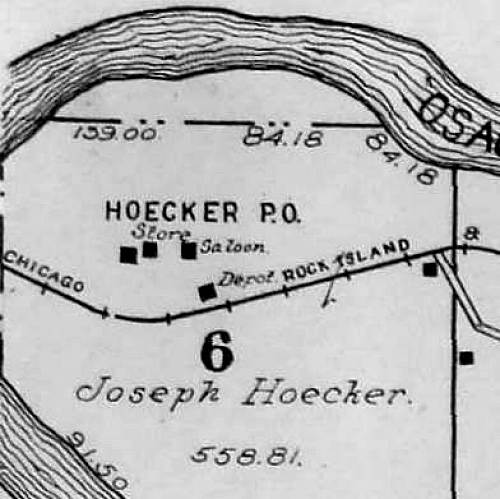
39 Hoecker Map You can see that the land around it was owned by Joseph Hoecker. When this map was drawn up in 1905 the Rock Island Railroad was only a few years old. The railroad crossed the Osage River to the West just out of view on the left side of the map.
To get to what is left of Hoecker today take Highway 52 to St. Elizabeth and take Highway E to the northwest out of town. Continue on E to Hoecker Road and turn left. You will pass by the well maintained Missouri State Conservation access to the Osage River on the left which is near the confluence of the Big Tavern Creek and the Osage River (photos 40 and 41).
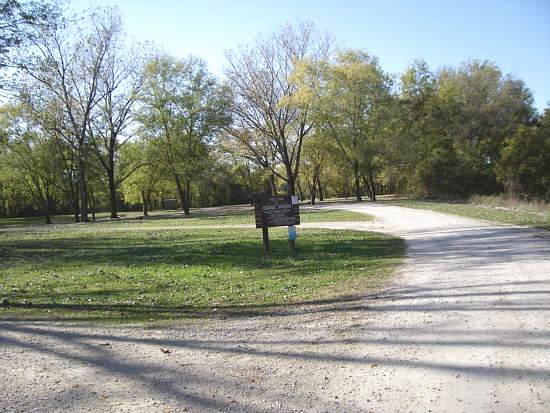
40 Missouri Conservation Access
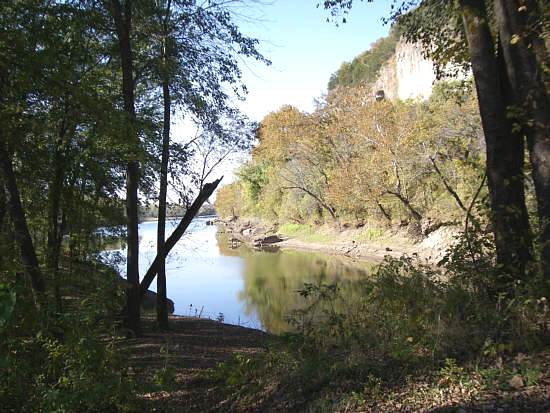
41 Confluence of Big Tavern and Osage This is a beautifully scenic area overlooked by high picturesque bluffs (photos 42 and 43).
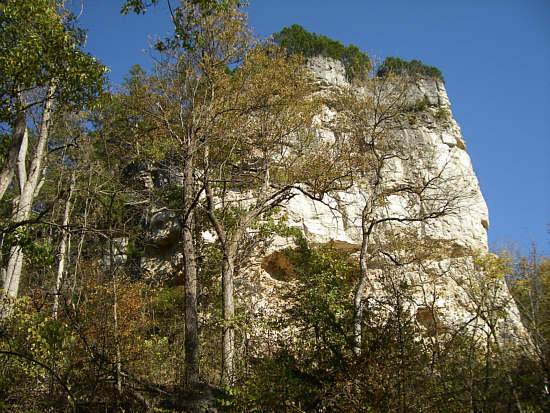
42 High Bluffs
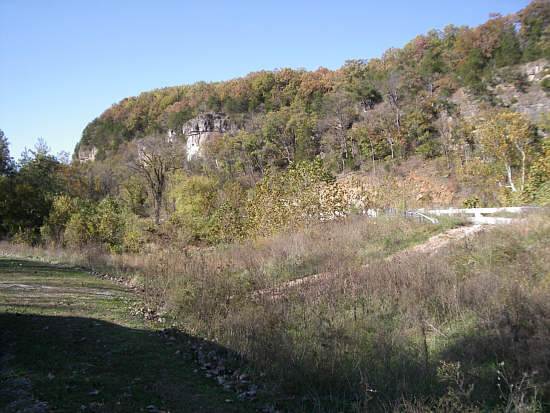
43 High Bluffs It is in these bluffs one finds the huge mouth of "Bat Cave", which is pictured poorly in this photo because of the overhanging tree branches (photo 44).
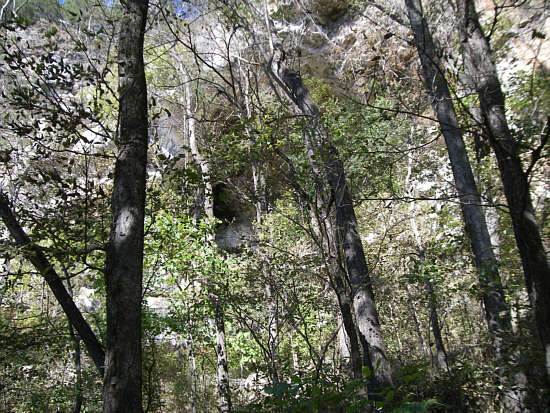
44 Bat Cave However, one can see the cave mouth very well looming above the steamboat J.R. Wells in this photo taken many years ago from a location across the river (photo 45).
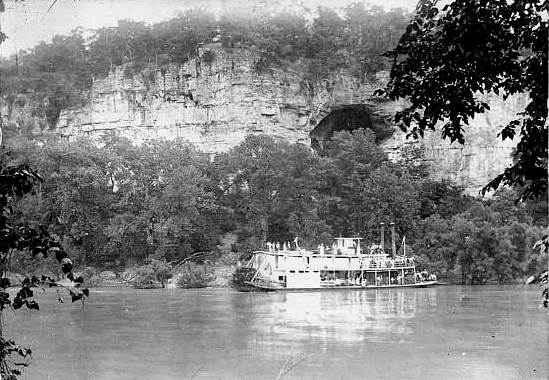
45 Bat Cave above J.R. Wells This cave is not open for exploration as the Conservation Commission wants to maintain a protected status of the cave for the purpose of not disturbing the bat population which breeds there (photo 46).
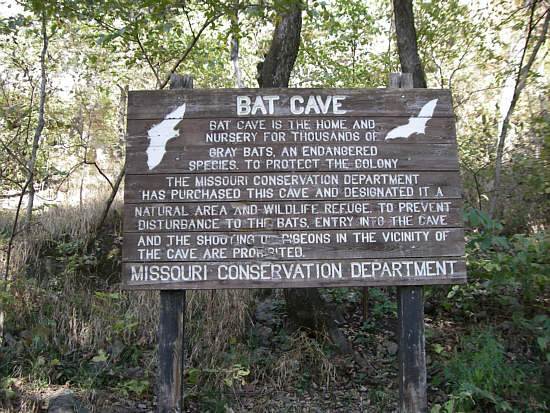
46 Bat Cave Sign Pass under the cave entrance and travel further along the river edge under the bluffs high above. Soon the road begins to turn away from the river heading toward the area where the town of Hoecker once was located. However, all evidence of the town is now gone, replaced by modern farm buildings and a home (photo 47).
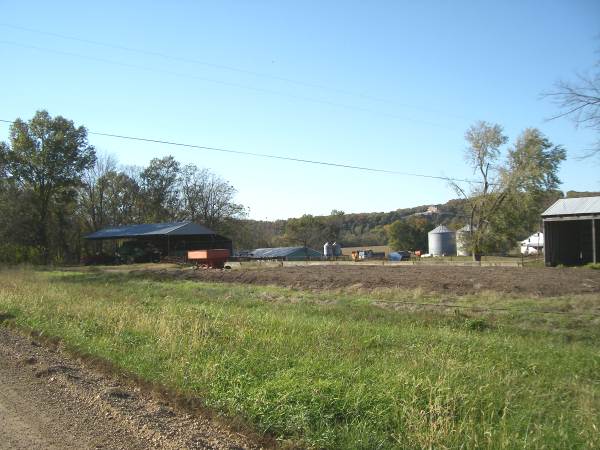
47 Farm where once was Hoecker As noted above the railroad once came through Hoecker near where the steamboat landing was located on the river. The railroad bridge across the Osage was also close by. Here is a photo of the bridge under construction many years ago (photo 48):
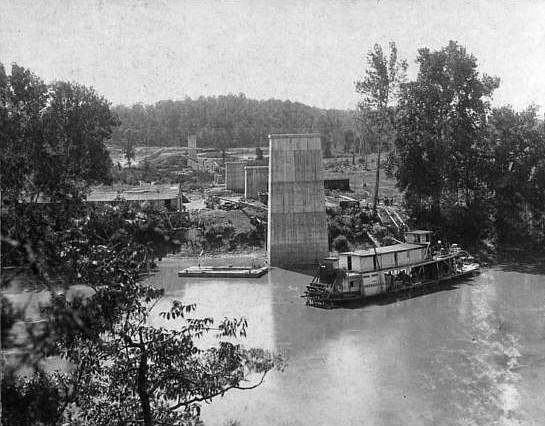
48 Hoecker Bridge Construction C.B. mentions the passengers on the boat for the trip. H.L. (Homer Lee) Wright (photo 49) was a brother to C.B. and was Bamber Wright’s father.
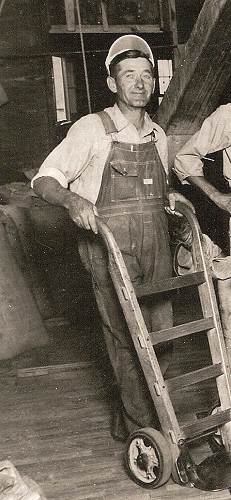
49 Homer Lee Wright “Sallie” was Sarah Riggins Haunstein (photo 50), wife of Phil Hauenstein and mother of Ida Hauenstein Hix (photo 51).
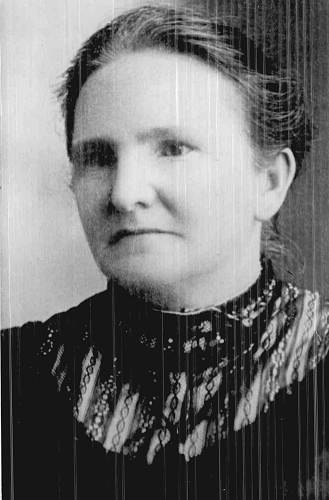
50 Sarah Sallie Riggins - Mother of Ida Hauenstein Hix
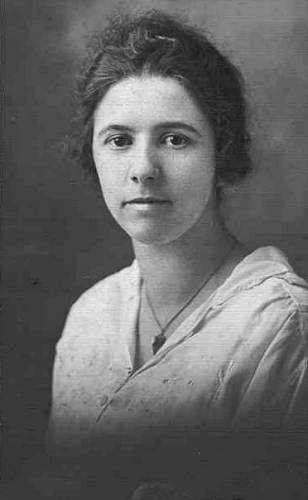
51 Ida Hauenstein Lizzie was Elizabeth Hauenstein Wright (photo 52), daughter of William Hauenstein 2nd, and husband of Homer Lee Wright (photo 53).
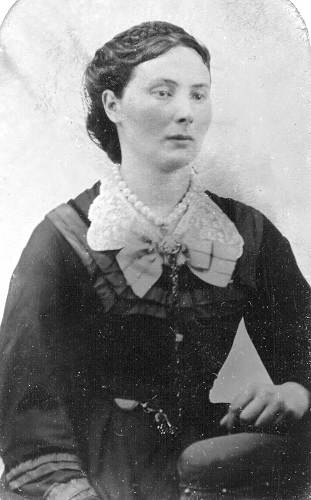
52 Lizzie Hauenstein
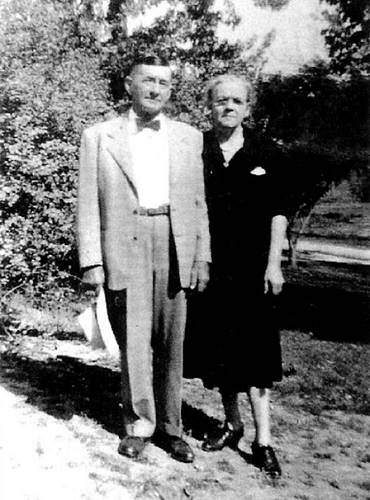
53 Homer Lee and Elizabeth Hauenstein Wright C.B. also mentions in the diary entry for June 14 that a “blown gasket” on the Mill’s boiler caused a delay in unloading brick. Homer Clay explains in the parenthesis that a “steam hoist” was used to pull a small flat car on rails up the river bank to the mill. It is amazing how many things in those days were powered by steam. The steam hoist also commonly was used by mining operations as well. Here is a photo of an old steam hoist (photo 54):
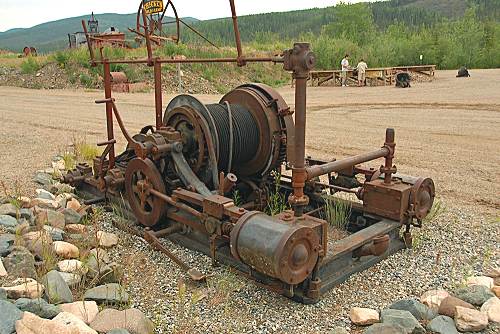
54 Steam Hoist You can read more about steam hoists at this URL:
During the winter months work is still going on at the museum. Jim Clark helped us tremendously recently to fix an insulation deficit due to an oversight on the construction of the new addition on the east side of the original museum. Someone during the initial construction forgot to insulate the area where the water pipe entered the building and it froze during the cold spell last week. Jim fairly quickly isolated the location of the frozen pipes, cut out the drywall, thawed the pipes, and then replaced and painted the drywall. We also appreciate “Dink” Musick coming to the museum to help us figure out where was located the frozen section. We are very fortunate to have Jim on board “our board” (he is a board member).
We are also fortunate to have others who come faithfully every Monday to help us with our probate file organization project anticipating the eventual microfilming of all these important historical documents. Jack and Joyce Brumley, Brice and Betty Kallenbach, Jody Newman, Helen Schulte, Karen Smith, Diane Berkbigler, Carl McDonald, Joe and Judy Pryor, Nancy Thompson were helping us last week. The effort now mainly is unfolding records and stacking them so that the microfilmers in Jefferson City can be spared that task before filming the files. The task is simple and very interesting as well. If you would like to help us just come to the museum around nine a.m. and we’ll get you started. You can leave whenever you want because it only takes a few minutes to unfold the records for any one individual file.
That’s all for this week.
 Joe Pryor
|



